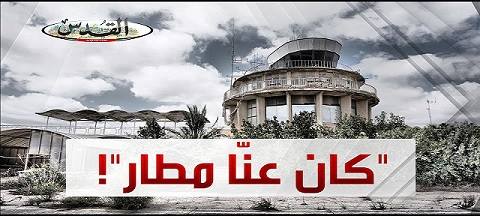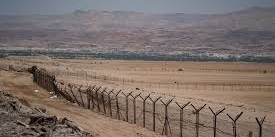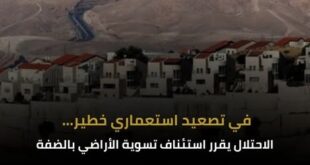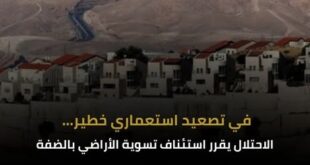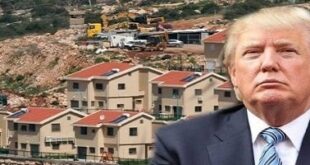By Madeeha Al-Araj
The National Bureau for defending land and resisting settlements ( nbprs ) stated in its latest weekly report , that last week, the Israeli government approved the general budget for the years 2021-2022, including a special budget for settlements. Minister of the Interior, Ayelet Shaked boasted of her success in doubling the budgets for settlements by more than 50%. It was also announced that millions of NIS would be allocated to complete settlement streets, as is the case in St. n. 60, which links the northern and southern West Bank, in addition to allocating budgets to complete the construction of road 437, which connects the Hizma area with Adam settlement, at a cost of NIS 250 million, which means confiscating large areas of Palestinian land, and allocating them for the benefit of settlers and settlements and linking them to each other. Shaked not only increased the settlement allocations in her ministry, but rather stressed the necessity of evacuating the village of Khan al-Ahmar, east of Jerusalem, and adhering to the decision of the Supreme Court.
At the same time, the Israeli occupation’s machines continue to work in the area of the Al-Quds Airport in Qalandia and establish basic infrastructure, after Al-Quds International Airport became a target for the implementation of Israeli expansionist plans after the government’s decision to convert it into an industrial zone. The local organizing committee considered that the land of Qalandia Airport, north of Jerusalem, is located in its lands, and decided to demolish the abandoned airport and turn it into an industrial area. The occupation has actually started work on a plan to build a new settlement neighborhood on the Qalandia Airport’s land despite the international opposition to the project. Knowing that Israel seized it after occupying the West Bank in 1967, and annexed it to the city of Jerusalem in 1981 under the ‘Jerusalem Law’ but closed it in 2000, and named it ‘Atarot Airport.’
The occupation established on the land of the airport the Qalandia checkpoint, which separates northern Jerusalem from Ramallah, and in Feb. 2012 decided to turn it into an industrial zone. This settlement plan was drawn up years ago, and was frozen on more than one occasion due to international political pressures, especially the opposition expressed by the previous US administration, headed by Barack Obama at the time, which opposed settlement expansion in Jerusalem. While the former Israeli Minister of Housing, Yoav Galant, issued orders to resume work on the settlement project after the election of the administration of US President Donald Trump, to be implemented these days during the era of the new Israeli government headed by Naftali Bennett, supported by Moshe Leon, the mayor of the occupation in Jerusalem.
The Occupation Municipality in Jerusalem has since begun work on the infrastructure and construction of several streets at the Qalandia Crossing, and promoting the settlement plan aimed at establishing a settlement neighborhood in the area on an area of 1,240 dunams of the airport land, which was approved by the “District Building and Organization Committee” in 2020. The works include construction 4 streets connect the Qalandia Airport area with settlements east of Jerusalem, as well as the Jordan Valley and the Palestinian coast, as well as building a road from the southern region to the city of Jerusalem to the cities of Bethlehem and Hebron. The settlement neighborhood includes the construction of 9,000 housing units for ultra-Orthodox “Haredi” Jews, in addition to the establishment of recreational and commercial places, an industrial zone, a 20-storey hotel, several high buildings, and other facilities supported by the Israeli far right.
As for the issue of the displacement of the families of Sheikh Jarrah neighborhood, Jordan submitted new documents proving the families’ ownership of their homes in the neighborhood, and submitted a proposal calling for the residents to be considered a ‘protected tenant,’ considering the current generation of residents to be the first generation and not those inhabited by the Jordanian government. The court’s proposal fell after the residents of the neighborhood rejected the proposed settlement, and the Jordanian authorities has submitted new documents proving the ownership of the Palestinian families threatened with eviction from the Sheikh Jarrah neighborhood of their homes in which they currently reside. The documents confirm that Jordan had already begun to transfer the ownership of the lands and buildings built on them in Sheikh Jarrah to them, but the June 1967 war and the consequent occupation disrupted these procedures.
The difference between these documents and the documents that were previously delivered last April is that the previous one spoke of intentions, while the documents delivered recently refer to practical steps to beatify the land in the names of the inhabitants. The documents stress that in March 1967, that is, 3 months before the outbreak of the war, ‘the residents of Sheikh Jarrah neighborhood received an announcement to wait for the measurement official in their homes in order to beatify the lands for them. A month later, the Jordanian taboo employee wrote to the Director of the Land Authority that the measurements path is complete, and you must go to the registration process in order to preserve the rights. The Jordanian media indicate that ‘the Jordanian documents are supported by the opinion of a former high-ranking official in the military prosecution of the occupation who worked in the West Bank, who confirms that based on them ‘the Jordanian documents’ can be concluded that the eviction of Palestinians from their homes is illegal.
Within this context, the UNs renewed its rejection of the occupation’s displacement of Palestinians from their homes in the occupied territories. This came in the comment of Stephane Dujarric, spokesman for the Secretary-General of the Organization, on the postponement of the High Court of the occupation’s decision on the petition of the 4 families against the decision to displace them from their homes in the neighborhood. Adding that, “the International law doesn’t permit settlements, nor does it permit the evacuation of Palestinians from their homes.” Also, the official spokesman for the US State Department, Ned Price, called on the occupation government not to expel Palestinians from their homes in which they lived for decades in the Sheikh Jarrah Neighborhood.
List of Israeli Assaults over the Last Week Documented by the National Bureau:
Jerusalem:
- Shooting live bullets against a young man near the Sheikh Jarrah neighborhood following a stand in solidarity with the people of the neighborhood, which led to him being slightly injured in his foot?
- Demolishing 16 commercial establishments in the town of Hizma, northeast of occupied Jerusalem, belonging to the Al-Khatib family
Hebron:
- Closing the Ibrahimi Mosque in front of Muslim worshipers under the pretext of Jewish holidays.
- Demolishing 3 houses each consists of 3 floors, with an area of 200m2 in Sa’ir under the pretext that they were built in C area.
Nablus:
- The funeral of the martyr Imad Dwaikat to his final resting place in the town of Beita in protest against the establishment of a settlement outpost on the lands. The citizen, Mo’men Husam Ahed Al-Faqih, sustained fractures after being pursued by a group of settlers from the Bracha settlement in the town of Iraq Burin, south of Nablus. The area is witnessing construction of settlement units and expansion at the expense of the citizens’ lands.
- Demolishing an agricultural room in the town of Sebastia, north of Nablus, and the razing of the surrounding land.
Ramallah:
- Demolishing 2 residential tents and a barracks built of tin, and dismantled two sheep tents in the Arab al-Ka’abneh community on the Al-Ma’arjat road east of Ramallah, then confiscated them, and then demolished several water wells in the community.
Bethlehem:
- Storming the “Ain al-Hawiya” area of Husan town, which includes a small pond and forest trees, and preventing Palestinian citizens from accessing it, destroyed about 140 olive seedlings in the lands of the town of Al-Khader, south of Bethlehem, and sprayed them with pesticides.
- Planting 14 dunums of olive, peach and almond seedlings in the citizens’ lands and built a settlement road of 100 meters in length and two meters in width in the lands of Kisan village, east of Bethlehem, with the aim of expanding the settlement of “Ibi Hanahel” .
- Notifying to demolish 2 agricultural rooms in the village of Al Walaja, northwest of Bethlehem, installing an iron gate at the entrance to Jabal Al-Fardis, east of Bethlehem, and built a communications tower. The forces demolished 5 agricultural rooms in the village of Wadi Rahal in the “Shaab Sultan” area of the village lands.
Jordan Valley:
- Bulldozing land in the Muwfeh Plain area, north of Khirbet Al Hadidiya, in the northern Jordan Valley, in preparation for their seizure, demolishing cement facilities in the “Draa Awad” area, north of the Hamra checkpoint in the Jordan Valley.
- Storming Khirbet Ibziq in the northern Jordan Valley, and began demolishing, dismantling and seizing 19 facilities, in addition to seizing 2 vehicles, and 4 residential tents, 4 sheep tents, 6 open sheds for sheep, 4 solar energy cells, and an electric generator, in addition to seizing 2 private vehicles.
 المكتب الوطني للدفاع عن الارض ومقاومة الاستيطان منظمة التحرير الفلسطينية
المكتب الوطني للدفاع عن الارض ومقاومة الاستيطان منظمة التحرير الفلسطينية
